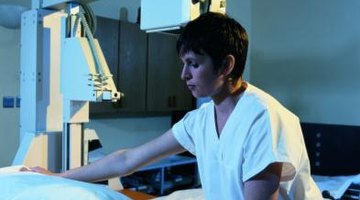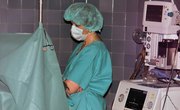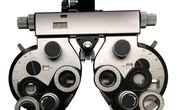X-ray technicians – also known as “radiologic technologists” – work with the most cutting-edge medical imaging equipment available to help physicians diagnose and treat various illnesses and injuries as accurately as possible. X-ray technicians work full-time in hospitals and any other health centers that offer X-rays, MRIs, CT scans or other imaging services. These professionals also work closely with patients, often answering basic questions about the relevant imaging procedure. Initial employment in this profession is contingent on an appropriate educational background.
High School Classes
High school students seriously interested in becoming X-ray technicians can increase their chances for success by excelling in relevant high school courses. Securing good grades in the sciences – especially biology, physics and, if available, anatomy – will help prepare students for their future college coursework. According to the Inner Body website, X-ray technicians must have solid written and verbal communication skills when working with doctors and patients. Therefore, high school students can benefit from the highest-level English and composition courses available in their high school. Computer courses can also be helpful, as X-ray technicians must be able to operate and, to a minor degree, maintain X-ray equipment.
College Coursework
Starting in 2015, all X-ray technicians must earn at least an associate degree from an accredited institution in order to be eligible for certification through the American Registry of Radiologic Technologists, according to the ARRT website. Radiologic technologist associate degree programs may vary slightly, but generally involve placement in clinical sites to help the student gain practical field experience while working under the direct supervision of a professional radiologist. Programs also usually include anatomy, physiology, physics and English composition courses.
Certification
Once students have earned their radiologic technologist or related associate degree from an accredited school, they are eligible to take the required radiography certification examination. According to the American Registry of Radiologic Technologists website, the exam is a requirement for licensing in most states. However, some states have further requirements for licensing, so aspiring X-ray technicians should make sure to investigate their particular state’s requirements before getting started on this career path.
Job Outlook
As human life expectancy increases, so does the need for competent health care professionals. According to the Bureau of Labor Statistics, the employment rate for radiologic technologists is expected to grow by 28 percent between 2010 and 2020, which is faster than average for most occupations. The bureau listed the median annual wage for this profession as $54,340 in 2010. In general, earnings for this profession are highest in high-need areas where there are less radiologic technologists available for hire.
Related Articles
References
Writer Bio
Bill Reynolds holds a Bachelor's degree in Communications from Rowan University. He has written hundreds of articles for print and online media, drawing inspiration from a wide range of professional experiences. As part of the UCLA Extension Writer's Program, he has been nominated for the James Kirkwood Prize for Creative Writing.











